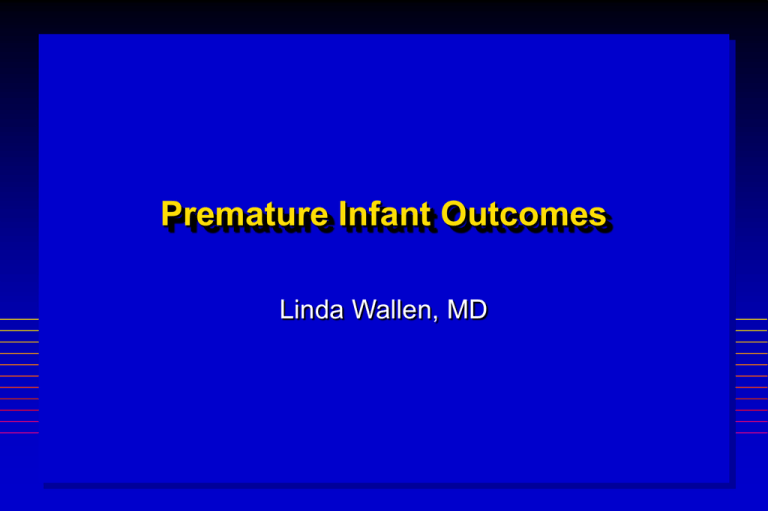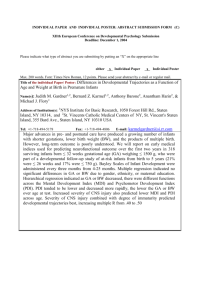Premature Infant Outcomes Linda Wallen, MD
advertisement

Premature Infant Outcomes Linda Wallen, MD Prevalence of Cerebral Palsy VLBW Infants - 1982-1994 Mortality (% live births) Cerebral Palsy (% survivors) 1982-1984 36.8 9.1 1984-1986 31.5 12.3 1986-1988 36.1 11.9 1988-1990 29.2 9.2 1990-1992 21.8 3.6 1992-1994 13.8 6.6 (O’Shea et al., 1998) Survival & Outcome of Infants Weighing <800 g 1979 to 1994 Dates (n) Survival CLD G 3 IVH/IPE Rehospital % (n) (% surv) (% surv) (% surv 1 yr) 1979-1984 (120) 20 (24) 23 10 29 1984-1989 (175) 36 (63) 66 21 49 1989-1994 (218) 59 (129) 61 12 53 (O’Shea et al., Pediatrics 100: 982-986, 1997) Survival & Outcome of Infants, 401-1250 g 1994 to 1996 BW (g) (n) Survival Severe IVH % w/o Sev IVH % (n) (n) % (n) 401-500 (497) 17 501-750 (5334) 60 (3110) 380 52 (2730) 751-1000 (6336) 89 (5501) 370 82 (5131) 1001-1250 (7201) 96 (6739) 285 92 (6454) (82) 6 15 (Finer et al., Pediatrics 104: 428-434, 1999) (76) Survival & Outcome of Infants, < 1250 g Doernbecher NCC, 1995 to 1998 BW (g) (n) < 500 g (11) 500-749 (57) Survival % (n) 63 (7) Severe IVH (n) 0 72 (41) 5 750-999 (104) 94 (98) 11 1000-1249 (107) 96 (103) 10 Bayley Scales at 30 Months for Infants Born at < 26 Weeks Gestation Individual Scores on Bayley Scales at 30 months by Gestational Age (EPIcure Group (UK) follow up Mar-Dec 1995. New England J Med 343:381, 2000) Risk Factors for Cerebral Palsy in Infants < 1000 g at 18-22 Months Adj. Risk for No Independent Walking Adj. Risk for No Independent Feeding From NICHD Network 1993-1994 Follow-Up. Pediatrics. 105:1221-22, 2000. Risk Factors for Severe Developmental Delay in Infants <1000 g at 18-22 Months Adjusted Risk Factors for MDI < 70 Adjusted Risk Factors for PDI < 70 From NICHD Network 1993-1994 Follow-Up. Pediatrics. 105:1220-21, 2000. 30 Month Outcome for Infants Born at < 26 Weeks No data (1%) Died (2%) Severe disability (25%) No disability (49%) Other disability (25%) (EPIcure Group (UK) follow up Mar-Dec 1995. New England J Med 343:381, 2000) NICHD Outcome of Infants 401-1000 g at Discharge BW (g) (n) Post-Neo Survival % CLD % Steroid Grade 3-4 Hosp d Rx % IVH/PVL % Median 501-600 (94) 98 51 68 16 119 601-700 (205) 96 49 59 23 109 701-800 (227) 98 45 50 22 99 801-900 (276) 97 36 38 18 84 901-1000 (295) 96 30 28 15 73 401-1000 (1111) 97 40 44 18 92 From NICHD Network 1993-1994 Follow-Up. Pediatrics. 105:1221-22, 2000. NICHD Outcome of Infants 401-1000 g at 18 Months BW (g) (n) CP % Blind Hearing Normal % Loss % Exam % 501-600 (94) 17 10 11 71 601-700 (205) 21 12 14 70 701-800 (227) 17 13 9 72 801-900 (276) 15 5 9 79 901-1000 (295) 15 5 7 79 401-1000 (1111) 17 9 11 75 From NICHD Network 1993-1994 Follow-Up. Pediatrics. 105:1221-22, 2000. NICHD Outcome of Infants 401-1000 g at18 Months BW (g) (n) 501-600 (94) MDI PDI MDI % PDI % Mn (SD) Mn (SD) < 70 <85 < 70 <85 73 (16) 75 (19) 45 70 34 65 601-700 (205) 74 (16) 76 (19) 41 72 35 62 701-800 (227) 74 (17) 77 (18) 42 68 31 50 801-900 (276) 77 (17) 80 (18) 35 67 25 52 901-1000 (295) 79 (18) 80 (18) 31 58 25 53 401-1000 (1111) 76 (17) 78 (18) 37 66 29 57 From NICHD Network 1993-1994 Follow-Up. Pediatrics. 105:1221-22, 2000. Growth Failure in the ELBW Infant Growth at 1 yr of infants 501-800 g born 1989-1994 – Head circumference < 10% = 35% (45/219) – Weight < 10% = 58% (75/219) – Length < 10% = 33% (42/219) Growth at 6-7 yr of infants < 750 g born 1982-86 – Head circumference < 3% = 35% (24/68) – Weight < 3% = 22% (15/68) – Height < 3% = 25% (17/68) Growth at 6-7 yr of infants 750-1499 g born 1982-86 – Head circumference < 3% = 14% (9/65) – Weight < 3% = 11% (7/65) – Height < 3% = 5% (3/65) Outcomes of ELBW infants Historical reasons for reliance on neurologic morbidities – Public misperception of prevalence of severe disability – Limitation of range of outcomes studied Other health outcomes that are affected – Increased incidence of asthma – Increased visual perceptual & expressive language disabilities – Increased behavioral problems – Growth failure – Family and child perception of health and outcome – Psychological outcomes Other factors which influence outcome = risk factors and post discharge environment, heavily influenced by maternal education, income level, smoking, poor maternal health (physical or mental)




